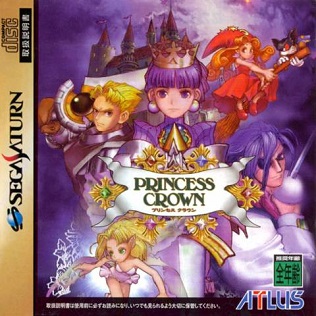Enix Corporation was a Japanese multimedia publisher who handled and oversaw video games, manga, guidebooks, and merchandise. It was founded in 1975 by Yasuhiro Fukushima as Eidansha Boshu Service Center, initially as a tabloid publisher and later attempting to branch into real estate management. Beginning in 1982, Enix began publishing video games. Three notable early collaborators were designers Yuji Horii and Koichi Nakamura, and composer Koichi Sugiyama. Horii, Nakamura and Sugiyama would all work on the 1986 role playing video game (RPG) Dragon Quest for the Family Computer; one of the earliest successful RPGs for consoles, it spawned a franchise of the same name which remains Enix's best-known product.

Atlus Co., Ltd. is a Japanese video game developer, publisher, arcade manufacturer and distribution company based in Tokyo. A subsidiary of Sega, the company is known for video game series such as Megami Tensei, Persona, Etrian Odyssey, and Trauma Center, as well as Print Club (Purikura) arcade machines. Its corporate mascot is Jack Frost, a snowman-like character from their Shin Megami Tensei series. Outside of video games, the company is known for their Purikura arcade machines, which are selfie photo sticker booths popular in East Asia.

Megazone 23 is a three-part Japanese cyberpunk original video animation co-created by Noboru Ishiguro and Hiroyuki Hoshiyama, written by Hoshiyama and Emu Arii, and directed by Ishiguro, Ichiro Itano, Kenichi Yatagai, and Shinji Aramaki. The series debuted in 1985. It was originally titled Omega Zone 23 but the title was changed just before release.

Fantasy Earth Zero was a 2006 massively multiplayer online role-playing game developed for Microsoft Windows. Originally developed by Puraguru and Multiterm under the title Fantasy Earth: The Ring of Dominion, it was released by Square Enix as a paid product through its PlayOnline service. It relaunched under Gamepot as a free game, and was later handled by developers SoftGear and Ocean Frontier and was transferred back to Square Enix. Under the premise of a world where rival kingdoms engage in frequent conflicts, players choose an allied kingdom and fight against each other in groups of up to fifty players. The game closed down in September 2022.
Noise Factory Co., Ltd. was a Japanese video game developer and publisher based out of Osaka, it was one of the developer companies of SNK, established by former Atlus staff members who previously worked on Princess Crown for Sega Saturn. Its more known games were Gaia Crusaders, Sengoku 3 and the new games of Rage of the Dragons & Power Instinct.

Princess Crown is an action role-playing game developed and published by Atlus in collaboration with Sega that was released only in Japan. Originally released in 1997 for the Sega Saturn, it was ported to the PlayStation Portable in 2005. Using a two-dimensional side-scrolling perspective, gameplay focuses on a beat 'em up-style fighting system, incorporating role-playing elements. Set in the fantasy kingdom of Valendia, the player controls queen Gradriel De Valendia, as her wish to aid the people in person leads into a quest to prevent the resurrection of the demon lord Lalva. Additional character scenarios are unlocked by completing Gradriel's quest, with completion of all story routes leading to the true ending.

GrimGrimoire is a 2007 real-time strategy video game developed by Vanillaware and published by Nippon Ichi Software and Koei (Europe) for the PlayStation 2. A remaster, GrimGrimoire OnceMore was released in Japan on PlayStation 4 and Nintendo Switch in 2022 and worldwide, along with a PlayStation 5 version, in 2023. The story follows Lillet Blan, a trainee witch who is sent into a repeating cycle of five days after her school is attacked by an evil wizard seeking the hidden Philosopher's Stone. The player commands units called familiars, each having strengths and weaknesses against the other, with the goal of either destroying the opponent's bases or surviving waves of enemies.

Odin Sphere is an action role-playing game developed by Vanillaware for the PlayStation 2. It was published by Atlus in 2007, and by Square Enix in 2008. A remake, titled Odin Sphere Leifthrasir, was released on PlayStation 3, PlayStation 4, and PlayStation Vita in 2016: Atlus handled publishing duties in Japan and North America, while NIS America published the title in PAL territories.

Muramasa: The Demon Blade is a 2009 action role-playing game developed by Vanillaware and published for the Wii by Marvelous Entertainment (Japan), Ignition Entertainment, and Rising Star Games (Europe). An expanded PlayStation Vita version was published in 2013 by Marvelous AQL in Japan and Aksys Games in Western territories. Using a 2D side-scrolling perspective, the gameplay revolves around a beat 'em up fighting system, while incorporating role-playing elements such as leveling and questing.

This is a list of development studios owned by Sega, a Japanese video game developer and publisher based in Tokyo, Japan. Accompanied with the list is their history of game development. Also included are the companies that Sega has acquired over the years. For a full list of games developed and published by Sega, see List of Sega video games, List of Sega mobile games and List of Sega arcade games.

Dragon's Crown is a 2013 action role-playing game developed by Vanillaware for the PlayStation 3 and PlayStation Vita. The game was published in Japan and North America by Atlus and in PAL regions by NIS America. A high-definition port for PlayStation 4, Dragon's Crown Pro, was released by Atlus in 2018. Players navigate environments from a side-scrolling perspective, choosing from six character classes to fight in the style of a beat 'em up and acquiring loot through repeated dungeon exploration. The storyline follows adventurers as they journey across Hydeland and become involved in the search for the magical Dragon's Crown.

Grand Knights History is a 2011 tactical role-playing video game developed by Vanillaware and published by Marvelous Entertainment for the PlayStation Portable. Following the adventures of a mercenary group in the employ of one of three warring nations, the player engages in turn-based combat while navigating maps. The game originally featured online competitive multiplayer where chosen teams of characters fight for their nation, but this ended when servers shut down in October 2013.

Kumatanchi is a life simulation video game co-developed for the Nintendo DS by Vanillaware and doujin studio Ashinaga Oji-san. It was published on September 25, 2008, by Dimple Entertainment. The premise and gameplay revolves around the player taking care of an anthropomorphic girl based on the mascot character Habanero-tan, seeing her interactions with other anthropomorphic characters over two weeks in real-time. Due to its gameplay and subject matter, it was only released in Japan.

Persona 4 Arena is a fighting video game co-developed by P-Studio and Arc System Works and published by Atlus for arcades, PlayStation 3, and Xbox 360; the game is a spin-off from the Persona series, itself part of the larger Megami Tensei franchise. The game was published by Atlus in Japan and North America in 2012, and by Zen United in Europe in 2013. Gameplay follows standard fighting game conventions, with matches between two characters with individual movesets, and special expendable abilities. The storyline is told through visual novel segments.

Grand Kingdom is a tactical role-playing video game developed by Monochrome Corporation for the PlayStation 4 and PlayStation Vita. It was published by Spike Chunsoft in Japan in 2015, and NIS America in the West in 2016. Following a mercenary group in the employ of different nations formed in the wake of a collapsed empire, the player engages in turn-based combat while navigating paths on maps similar to a board game. Online competitive asynchronous multiplayer where chosen teams of characters fight for a chosen nation was originally featured, but this ended as servers were shut down by 2019 in the West and 2022 in Japan.

13 Sentinels: Aegis Rim is a 2019 video game developed by Vanillaware and published by Atlus. It was released for the PlayStation 4 in Japan in November 2019 and worldwide in September 2020, with a Nintendo Switch version released in April 2022. The game is divided between side-scrolling adventure segments and real-time strategy (RTS) battles, and follows thirteen high-school students in a fictionalized 1980s Japan who are dragged into a futuristic war between mechas and hostile Kaiju in a nonlinear narrative.

Unicorn Overlord is a 2024 tactical role-playing game developed by Vanillaware and published by Atlus in Japan, and Sega worldwide, for Nintendo Switch, PlayStation 4, PlayStation 5 and Xbox Series X/S. Set on the continent of Fevrith as it is consumed by war, the story follows exiled prince Alain as he gathers allies to liberate the nations of Fevrith from the Zenoiran Empire. Gameplay follows Alain and his army units fighting in large-scale battles, with field movement and battles taking place in real-time.
Sword of the Vagrant is a hack and slash side-scrolling role-playing video game. It was developed by Beijing-based studio O.T.K Games and published by SakuraGame and Rainy Frog LLC. The game was released on June 9, 2017, for Windows, and was later released on Nintendo Switch, PlayStation 4, Xbox One, and Xbox Series X/S on December 1, 2022. The game follows a female sellsword named Vivian who travels to the island of Mythrilla in search of her missing father. There, she is cursed and forced to serve an evil witch. The game is notable for its heavy graphical inspiration from Vanillaware titles such as Muramasa and Dragon's Crown. It received mixed reviews from critics, who praised its graphics, but called its gameplay simplistic, albeit worth the low price of the PC version.

The Amazon is a character introduced in the 2013 side-scrolling beat 'em up roleplaying game Dragon's Crown, developed by Vanillaware. A tall blonde muscular woman specializing in melee attacks, she is intended to have low defense, but able to deal large amounts of damage. Created by George Kamitani, her animations for the game were done by illustrator Shigatake. She additionally appears in a manga novelization of the game, and in a comic series published in Famitsu. In Japanese the character is voiced by Atsuko Tanaka, while her English voice actress is uncredited.















